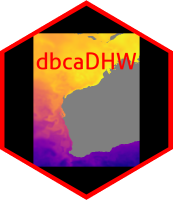
Introduction
The aim of this vignette is to show an interpretation of NOAA’s Coral Reef Watch degree heating week metric (DHW), see here for details.
By following the vignette Using dbcaDHW there will be a csv of SST values and a folder structure that this analysis will utilise. Please read that vignette first if you haven’t done so.
Degree heating weeks
The following will create 2 csv files as output. One, including “DHW” in the name, will contain a daily record of the the DHW for the defined present period. The other csv with “DHWM” in the name, will contain the overall maximum DHW metric achieved for each site for the defined present period.
First up load up other required packages, read in the previously created data and set up a few useful objects.
library(tidyverse)
library(lubridate)
library(tibbletime)
## read in extracted daily values
dataset <- read_csv("CRW3_1_extract_yourstartdate_yourfinishdate_SST_data.csv")
## sites
sites <- names(dataset)[-1]
g_num <- length(sites) + 1Next up the past period and a maximum monthly mean will be calculated. For our purposes this metric (mmmt) will serve as the threshold temperature. Please adjust the past period date to suit your needs/data.
## create maximum monthly mean from "past period"
mmtdata <- dataset %>%
tidyr::gather("site", "sst", 2:all_of(g_num)) %>%
dplyr::filter(dates < "2010-08-01") %>% #define past
dplyr::mutate(month = month(dates),
year = year(dates)) %>%
dplyr::group_by(site, year, month) %>%
dplyr::summarise(avg = mean(sst)) %>% #obtain mthly avgs
dplyr::group_by(site) %>%
dplyr::summarise(mmmt = max(avg)) #obtain max mthly avgThe DHW calculation is assisted by creating a function to do the work of a rolling 12 week “sum”. A present period also needs to be defined. Again change this to suit your needs. Note, the code snippet below focuses on temperatures that exceed the mmt by 1 degree or greater as per the Coral Reef Watch example linked above. This may or may not suit your needs so adjust accordingly.
## function for rolling cusum of 12 weeks - 84 days)
dhw_calc_12 <- tibbletime::rollify(sum, window = 84)
## observation period, hotspot & dhw calc
dhw <- dataset %>%
tidyr::gather("site", "sst", 2:all_of(g_num)) %>%
dplyr::filter(dates >= "2010-08-01" & dates <= "2011-07-31") %>% #define present
dplyr::mutate(month = month(dates)) %>%
dplyr::full_join(mmtdata, by = "site") %>%
dplyr::mutate(hspt = sst - mmmt,
hsptm = ifelse(hspt >= 1, hspt, 0),
dhw = dhw_calc_12(hsptm)*(1/7)) %>% #hotspot based on 1 degree
dplyr::select(-month, -hsptm)Lastly create the summary DHWM data and write all to csv.
dhwm <- dhw %>%
dplyr::group_by(site) %>%
dplyr::summarise(dhwm = max(dhw, na.rm = TRUE))
write_csv(dhw, "SB_CRW3_1_SST_DHW_present.csv")
write_csv(dhwm, "SB_CRW3_1_SST_DHWM_present.csv") To summarise. From the past period, monthly sst was calculated per site and then the maximum was chosen to represent the maximum monthly mean temperature or mmmt.
This single value per site was then added to the present period data where it was taken away from the observed sst. This value becomes a hotspot value and used as a threshold temperature. Following work outlined on Coral Reef Watch any hotspot value greater than or equal to one was cumulatively summed within a moving 12 week window. As the Coral Reef Watch method was based on bi-weekly hotspot data rather than daily, the cummulative summed value was multiplied by 0.14 (1/7) to arrive at the degree heat weeks metric, DHW.
As the DHW is calculated in a moving window a summary of this metric was considered as the maximum value calculated for each site for the present period, i.e. DHWM.
Two out puts are generated.
SB_CRW3_1_SST_DHW_present.csv which contains the following headers:
-
dates- Date -
site- The unique site Id. There are 600 and if visualised as a grid covering Shark Bay, they start at the top left hand corner and run from left to right. -
sst- Sea Surface Temperature as extracted from the Coral Reef Watch version 3.1 data. -
mmmt- Maximum Monthly Mean Temperature. -
hspt- Hotspot. This issst-mmmtgiving a positive value for values exceeding themmmtthreshold. -
dhw- Degree Heating Weeks. An NA indicates not enough values for a 12 week calculation.
SB_CRW3_1_SST_DHWM_present.csv which contains the following headers:
-
site- The unique site Id. There are 600 and if visualised as a grid covering Shark Bay, they start at the top left hand corner and run from left to right. -
dhwm- Degree Heating Weeks maximum.